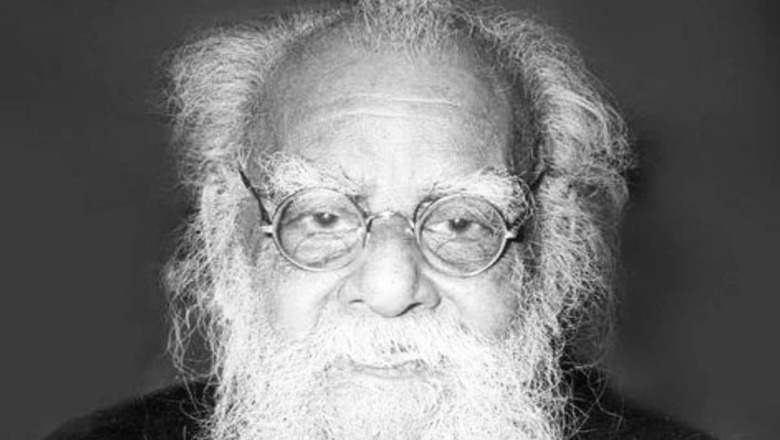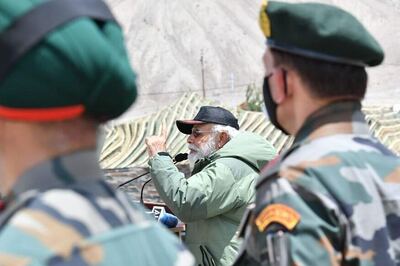
views
Bishop Robert Caldwell, the Church-ordained missionary, had nearly three centuries’ worth of past masters to guide him. The first is the well-known fraud, the “Roman Brahmin,” Roberto Di Nobili (1577-1656) who used the sacred Sanatana city of Madurai for his soul-harvesting activities. But more than Nobili, it was his worthy successor, the Italian missionary Constantius Beschi (1680-1743) who decisively changed the direction, focus, and tactics of harvesting Hindu souls in Tamil Nadu.
Beschi was well-versed in Sanskrit but he consciously avoided using Sanskrit terms in his Tamil compositions in praise of St. Joseph, for example. Pompously titled Thembavani (The Unfading Garland), he describes it as an “ornament of poems as sweet as honey” (sic). It contains 3615 stanzas tracing the history of Salvation and the life of St. Joseph.
Beschi is perhaps the first Italian missionary to sow the seeds of Sanskrit destruction in the Tamil Desam. He wrote a series of Tamil grammar and linguistics, profusely praising the grandeur and greatness of this ancient language. Beschi is also the first European scholar of the Tamil language who elaborately delineated the distinction between “chaste” and “colloquial” Tamil and expounded in detail on Tamil classical literature. With this, Beschi had laid sturdy foundations, which have endured till date — i.e., for more than three centuries.
Cut to the1920s. Dravidian politicians suddenly rediscovered Beschi and hailed him as a great model of a European who had been so impressed by the sophistication, beauty and intricacy of the Tamil language, that he devoted his entire life to mastering it. Along with Caldwell, Beschi is another figure greatly revered in the annals of the Dravidian myth-making ideology. It elevated him to cult status, christening him as Vīramāmunivar (literally: The Warrior Sage).
On January 2, 1968, the DMK government erected the statue of this “Vīramāmunivar” on Marina Beach. It is equally unsurprising that in 1954, a certain Thomas Srinivasan wrote a laudatory article (Beschi, the Tamil Scholar and Poet: Tamil Culture Vol III, 1954) on Beschi’s contribution to Tamil. The enduring foundations laid by Beschi would eventually demolish the Sanskrit Department of Presidency College, Madras, after India attained independence. Almost since its inception, the department had been sanctified by a distinguished lineage of extraordinary Sanskrit scholars including Sri Rangacharya, Kuppuswami Sastri, and P.P. Subramhanya Sastri who all left behind an equally illustrious scholarly progeny such as C. Kunhan Raja, V. Raghavan, T.N. Ramachandran and others.
But it took about a decade for the Dravidianists to annihilate this glorious legacy root, branch and leaves.
In the heydays of his violent, streetside Dravidian activism, EV Ramasamy Naicker issued a public declaration: “When we think of ourselves as Sudras, we accept ourselves as the sons of prostitutes.” The fact that he is still hailed as Periyar (The Elder or Respected One) by a significant chunk in Tamil Nadu is deeply reflective of a celebration of cultural destruction. A glimpse into the overall history of Tamil cinema offers innumerable and continuing proofs of this fact.
Ramasamy Naicker achieved his triumphs with greater speed and success where his senior and junior contemporaries had failed because he employed a simple device that his predecessors had been hesitant to use: the brazen deployment of violent and obscene language in public. Even here, Ramasamy Naicker showed no originality. He directly plagiarised the tactics of Lenin who infamously extolled the effectiveness of “sticking the convict’s badge on your opponent” as a method of circumventing serious intellectual debate which he was destined to lose.
The calculated destruction of Sanskrit in Tamil Nadu was the direct and associative outcome of inveterate Brahmin hatred espoused by the Dravidianists. From the start, the Dravidianists adopted a scorched earth policy of destroying everything that could remotely be considered Brahminical: the Sanskrit language and literature, temple traditions and social customs. But the most effective imaginary enemy that they created and vilified was Sanskrit: specifically, Sanskrit as opposed to Tamil.
Apart from Ramasamy Naicker, other major players of the so-called “Self-Respect Movement” and later the Justice Party, included J.N. Ramanathan, son of Nallaswami Pillai (author of Sivajnana Bodham), and J.S. Kannappar who had publicly burned copies of the Manusmriti in Madurai. They quickly understood the power of organised violence. In all the violent incidents that they unleashed, there is an echo of a famous proverb regarding the successes of Islamic invasions into India: while the Hindus were busy brushing up theological and philosophical arguments, the warriors of Islam were busy sharpening their swords.
And here, the Dravidianists were busy writing inflammatory pamphlets and delivering provocative speeches against Brahmins, Sanskrit, Hindu deities, Puranas, etc. One such disgusting pamphlet that appeared in 1929 was titled the Visittira tevarkkal korttu (The Wonderful Court of Hindu Deities). It used the literary device of a court of law in which revered Hindu deities were put on trial and cross-examined for the various sexual and violent crimes they had allegedly committed against the non-Brahmins, and harsh punishments were imposed on them. The pamphlet concluded that the entire Hindu “religion” was a mass of superstition and had to be wiped out from the Tamil land.
Sure enough, riots and arson erupted in various parts of Tamil Nadu at regular intervals during the first two and half decades of the twentieth century, all thanks to these brazen tactics of the Dravidianists. The Dravidianists couldn’t have achieved the kind of success they did without the tacit and at times, open support of the British, not to mention the Christian missionary apparatus, which was rubbing its hands in glee at the kind of brood that Caldwell had spawned.
At the root, Robert Caldwell, like his predecessors, had the destruction of Brahmins in mind because they formed the chief obstacle to his conversion project. But he masked this sinister intent by announcing that what he was really doing was scholarly work in Tamil linguistics. But by using linguistics as a pretext, he manufactured the spurious sociological equation that Brahmins=Aryas=evil north Indian invaders=oppressors of Dravidians.
To be continued
The author is the founder and chief editor, The Dharma Dispatch. Views expressed in the above piece are personal and solely that of the author. They do not necessarily reflect News18’s views.



















Comments
0 comment